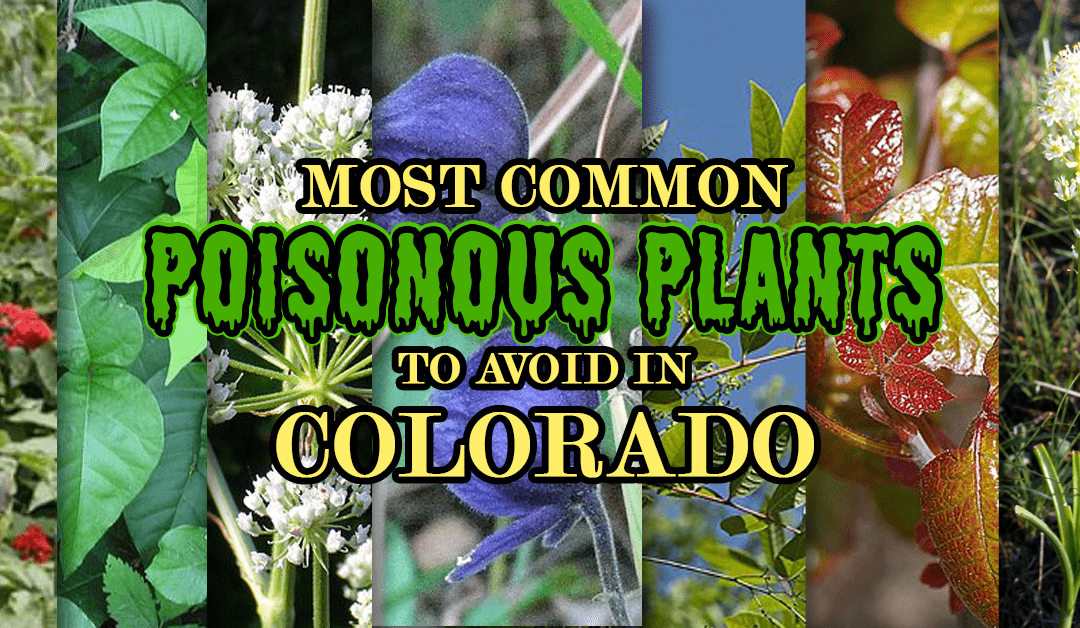Most Common Poisonous Plants in Colorado.
Whether you are an avid hiker, explorer, or weekend warrior, Colorado’s mountains offer some of the absolute best getaways, stunning views, and challenging climbs. Deep in the lush hills of our great state flowers are a-blooming and we have some beautiful flowers! But, beware, fellow travelers, for not all flowers you see on these journeys are as they seem!
Colorado’s mountains have many beautiful plants to entrance you and some fantastic edible plants too! But, some can mean the difference between sickness and health, and even life or death! So join us in this journey as we have made a list of the most common poisonous plants in Colorado!
Be 100% Sure.
Any person who puts themselves in contact with or ingests wild plants or mushrooms for any reason does so at their own risk. Knowing when to pick, touch, or consume a plant is essential. The first rule of foraging is “be 100% sure that you are 100% sure.”
What does this mean? Never touch a plant unless you are 100% sure you know what it is and that you are 100% sure that you are sure. Get it? If you have ANY doubts about a plant, leave it be.
There are many look-alikes in the plant kingdom and with 390,900 plants known to science, even professional botanists can sometimes mislabel a plant species and subspecies.
Colorado is home to a few toxic plants that may seem friendly on the first appearance but can lead to some disastrous encounters. So be wary, and above all, be sure.
It is important to remember that these plants aren’t vicious out of simple spite for humanity. They are simply protecting themselves and ensuring that their species lives on! So always go into Mother nature with reverence, and remember that some of these species are older than humanity itself.
The 5 Most Common Poisonous Plants in Colorado
Now that the finger-wagging mumbo jumbo is out of the way, let’s dive into our list of the most common poisonous plants in Colorado!
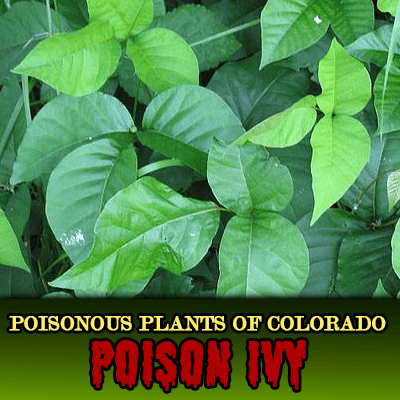

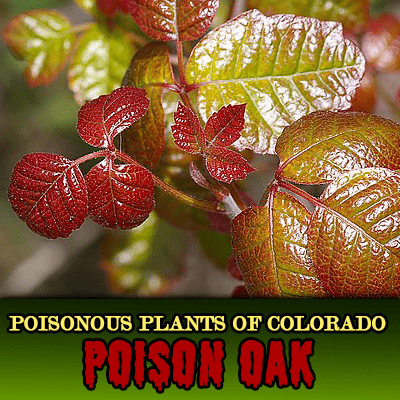
Poison Oak, Poison Ivy, Poison Sumac – The Three Sisters of Suffering
(Toxicodendron radicans, Toxicodendron diversilobum, Toxicodendron vernix)
These three plants are listed together because although all three look different, they all have a sticky, long-lasting oil called urushiol that causes an itchy, blistering rash after it touches your skin. The rash forms within 24 to 72 hours of contact, depending on where the plant touches you. It usually peaks within a week but can last as long as three weeks.
- You may have heard the phrase “Leaves of three. Let it be”. This is only true with Poison ivy. They’re shiny with smooth or slightly notched edges.
- Poison oak looks similar, but the leaves are larger and more rounded like an oak leaf. They have a textured, hairy surface. There may be groups of three, five, or seven leaves.
- Poison sumac leaves grow in clusters of seven to 13 leaves, one by itself at the end. Beware of where you step!
All three grow in wooded or marshy areas. They aren’t considered poisonous, but they have some of the nastiest bites in the plant kingdom.
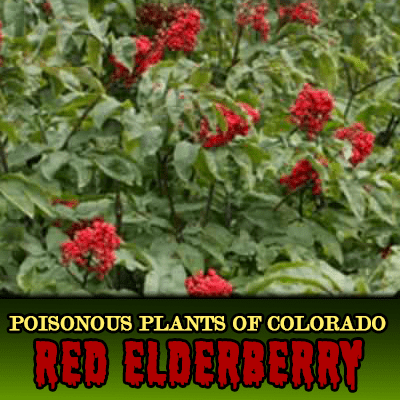
Red Elderberry – A Tricky Cousin
(Sambucus racemosa)
Red elderberry is a cousin of the highly sought-after black elderberry. Red elderberry is a large deciduous shrub of the Honeysuckle family. It typically grows 10-20 ft tall with a broad arching form. Older specimens have large, multiple trunks with coarse bark.
Red elderberry begins growth early in spring and produces abundant, small, creamy white flowers in large, conical, or pyramidal-shaped clusters between April and July. Unfortunately, the red elderberry seeds inside the fruit are toxic and can induce heavy vomiting and diarrhea.

Death Camas – She Earns Her Name
(Zigadenus elegans)
This plant is deadly poisonous. All fresh parts of deathcamas (leaves, bulbs, flowers) are toxic. Dried parts, mainly seeds, and capsules, are even more potent. Ingestion by humans can cause severe illness and occasionally death, even for adults. The tricky thing about this plant is that it looks very similar to the edible wild onions! However, the bulbs of Death Camas lack the distinctive onion scent, and the leaf is more dry and grasslike.
Death Camas has a v-shaped leaf structure with a long central bend in the blade, while wild onion has a more curved and U-shaped leaf. So be cautious, always 100% sure.
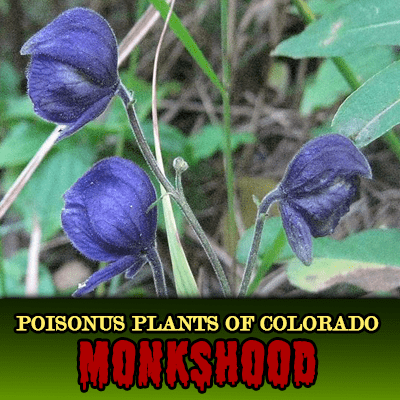
Monkshood – Bane of the Wolves
(Aconitum napellus)
This gorgeous and unassuming purple flower allures and entrances. But be wary; all parts of Monkshood are poisonous, especially the roots and seeds and the flowers if eaten.
Monkshood’s principal toxins are monobasic diterpenoid alkaloids, including aconitine, mesaconitine, and hypaconitin. In the past, wolves and criminals were poisoned with an extract from the European Aconitum lycoctonum, which is pretty much how it got its nickname, wolfsbane. This species was also supposedly used as a component in witches’ brew.
Symptoms appear within a few minutes of consumption. The initial signs are gastrointestinal, followed by a sensation of burning, tingling, numbness in the mouth and face, and burning in the abdomen, followed by death.

Poison Hemlock – A Famous Foe
(Conium maculatum L.)
Poison Hemlock is famous for supposedly being the plant Socrates used to kill himself. Poison Hemlock is a stunning beauty, with terrifying effects.
It is a herbaceous biennial flowering plant that grows to 5–8 ft tall, with a smooth, green hollow stem, usually spotted or streaked with red or purple on the lower half of the stem. It looks a lot like a few edible plants, so be careful!
The general symptoms of hemlock poisoning are effects on the nervous system. Beginning with stimulation similar to caffeine, the heart rate accelerates, followed by paralysis of motor nerve endings and then depression and sedation. Next comes, vomiting, trembling, problems in movement, rapid respiration, salivation, urination, nausea, convulsions, coma, and finally, death.
Be sure to watch out for these beautiful purple flowers, too! – Lupines, Locoweed, and Larkspur.
So there you have it! Colorado is a beautiful playground for an outdoor explorer. But with all these poisonous plants, be sure to take care where you tread and be respectful of nature.
Happy Trails!
Information provided by this blog is not intended to diagnose, prescribe or treat any illness. Always consult a medical professional when suffering from any illness or injury. If you believe you have come in contact with a poisonous plant, call poison control immediately. Call Poison Control (800) 222-1222
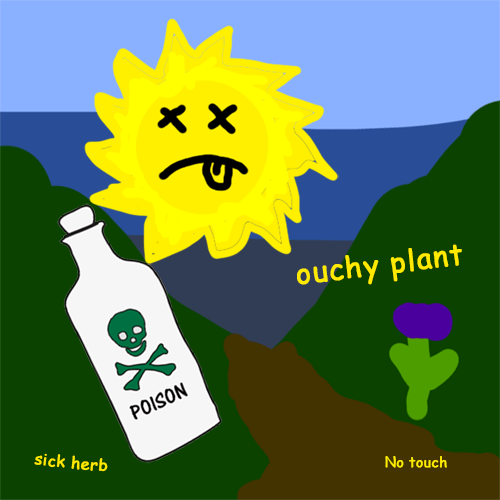
Citations:
https://www.thedenverchannel.
https://www.webmd.com/
http://nativeplantspnw.com/
https://www.fs.fed.us/
https://en.wikipedia.org/wiki/
https://www.outtherecolorado.
https://coloradowildflower.

